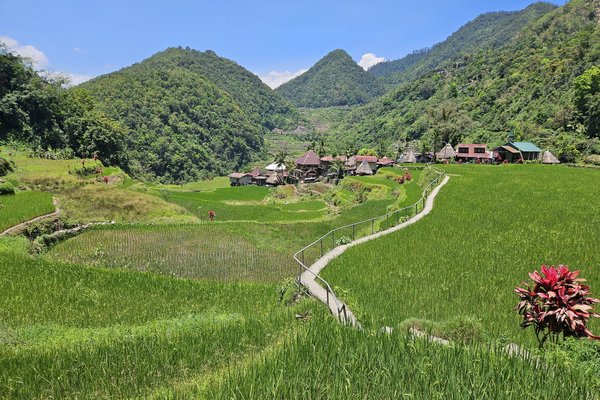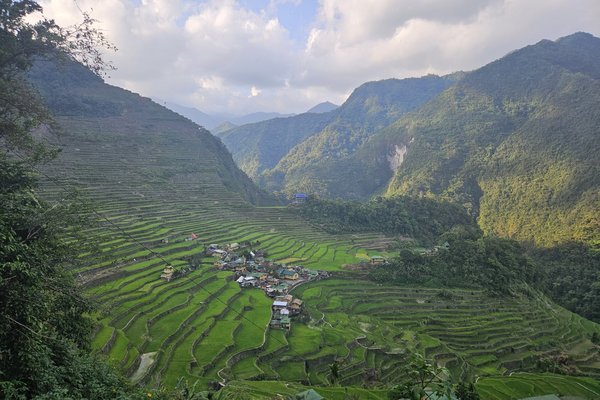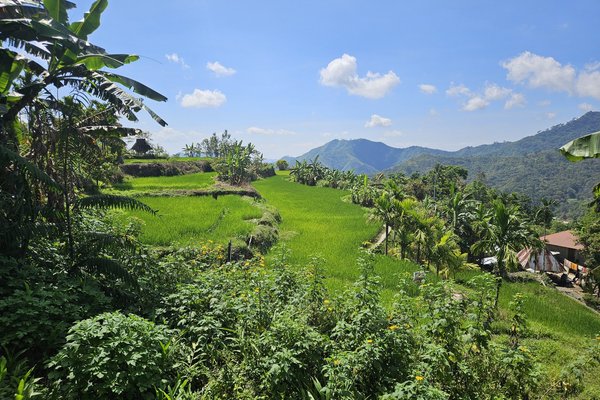Philippines
Rice Terraces of the Philippine Cordilleras
The Rice Terraces of the Cordilleras comprise a cultural landscape developed 2,000 years ago by the Ifugao people.
The five included clusters of terraces are still in use, and are under continuous maintenance by the current Ifugao farmers who work together as a community. The terraces are located up to 1500 meters above sea level and have steep slopes. A complex system of dams, sluices, channels and bamboo pipes keeps whole groups of terraces adequately flooded by water coming from the mountaintops.
Community Perspective: Banaue is the main hub to see these rice terraces, but you have to take a separate day trip outside of town to reach one of the included components. Bernard, Riccardo and GabLabCebu all have visited multiple of the terraces over 2-3 days.
Site Info
Official Information
- Full Name
- Rice Terraces of the Philippine Cordilleras (ID: 722)
- Country
- Philippines
- Status
-
Inscribed 1995
Site history
History of Rice Terraces of the Philippine Cordilleras
- 2012: Removed from Danger list
- 2001: In Danger
- Abandoning of the terraces
- 1995: Inscribed
- Inscribed
- Type
- Cultural
- Criteria
- iii
- iv
- v
Links
- UNESCO
- whc.unesco.org
- Official
-
- visitphilippines.org — Tourism Philippines
All Links
UNESCO.org
- whc.unesco.org — whc.unesco.org/
Official Website
- visitphilippines.org — Tourism Philippines
News Article
- Oct. 27, 2013 globalpost.com — Wakeskating Stunt at Philippine rice terraces draws ire
- April 1, 2013 philstar.com — Illegal miners tunneling Banaue Rice Terraces
- Jan. 23, 2010 allheadlinenews.com — An international non-profit has donated a $1 million hydropower plant to help stop the deterioration of the Philippine rice terraces
- Sept. 9, 2008 newsinfo.inquirer.net — No budget for Rice Terraces
- Dec. 4, 2007 business.inquirer.net — Migration, the lure of easy tourist money and a plague of giant earthworms imperil the 2,000-year-old structures that follow the contours of the Cordilleras mountains.
- Sept. 23, 2007 newsinfo.inquirer.net — Ifugaos are going to choose for themselves whether or not they should preserve the centuries-old rice terraces in the province.
- Aug. 24, 2007 manilastandardtoday.com — The Ifugao Rice Terraces could be stricken off the Worldin two years.
Community Information
- Community Category
- Human activity: Agriculture
- Cultural Landscape: Continuing
Travel Information
Recent Connections
-
No Map
-
Austronesian cultures
Igorot Peoples
-
Perfect Inscriptions
1995
Connections of Rice Terraces of the Philippine Cordilleras
- Geography
-
-
Antipodes points
Rice Terraces N16 56 2.004 E121 8 12.012 versus Pantanal Conservation Area S17 43 0.012 W57 22 59.988
-
- Trivia
-
-
On Passports
On Philippine passportSee news.abs-cbn.com
-
Slow Food Movement
Tinawon rice is the organic rice grown in the rice terraces of Banaue (Batad and Bangaan) and in Kiangan
-
- Ecology
-
-
Carnivorous plants
local carnivorous pitcher plants can be seen all over the province of Ifugao
-
- Damaged
-
-
Affected by El Niño
Banaue rice terraces
-
- World Heritage Process
-
-
Perfect Inscriptions
1995 -
No Map
-
Former In Danger List sites
2001-2012
-
- Human Activity
-
-
Austronesian cultures
Igorot Peoples
-
Man-made Terraces
-
Irrigation and drainage
Gravity-fed irrigation system, utilizing water from aquifers in the forests 2,000 feet above. -
Rice cultivation
-
- WHS on Other Lists
-
-
UNESCO 'LEAP' program
-
Historic Civil Engineering Landmarks
For Water Supply and ControlSee www.asce.org
-
UNESCO Intangible Cultural Heritage Lists
The Hudhud Chants of the Ifugao -
U.S. Ambassadors Fund
Documentation of the Oral Traditions of Ifugao (2008), Preservation of the Rice Terraces of the Philippine Cordilleras, a World Heritage Site (2007) -
Globally Important Agricultural Heritage Systems (GIAHS)
Ifugao Rice Terraces Philippines (pilot)See www.fao.org
-
Selected for the "Preserving Legacies" project
-
World Monuments Watch (past)
(2000), (2010)
-
- Timeline
-
-
Built in the 1st century
"lt is believed that terracing began in the cordilleras some two thousand years ago" (AB). In fact it is not known when the terraces began to be constructed and the issue is closely tied to the variuos theories about immigration patterns to the Island. Elsewhere it is stated that construction goes back 6000 years.
-
- Science and Technology
-
-
Innovations in Agriculture
The principal differences between the Philippines terraces and those elsewhere are their higher altitude and the steeper slopes. The high-altitude cultivation is based on the use of a special strain of rice (AB ev)
-
- WHS Names
-
-
Named after individual people
Philip of Spain
-
News
- globalpost.com 10/27/2013
- Wakeskating Stunt at Philippine ri…
- philstar.com 04/01/2013
- Illegal miners tunneling Banaue Ri…
- allheadlinenews.com 01/23/2010
- An international non-profit has do…
Recent Visitors
Visitors of Rice Terraces of the Philippine Cordilleras
- Adrian Turtschi
- Alejandro Lau
- Ammon Watkins
- Atila Ege
- Bernard Joseph Esposo Guerrero
- Bill Maurmann
- Boj
- Bram de Bruin
- Carlo Sarion
- chiuliqi
- Cholden324
- Chole Ross
- Clyde
- Corinne Vail
- czesioszpachelka
- David Scott King
- Dylan
- Els Slots
- Erik Jelinek
- Errol Neo
- Fan Yibo
- Felicité
- Fernweh
- Gabbro
- GabLabCebu
- Garrett
- Gary Arndt
- headventure
- hegeline@icloud.com
- henryjiao18
- Iain Jackson
- Jacob Choi
- JL
- Jon Eshuijs
- Jon Opol
- Joyce van Soest
- Justin Rickey
- jxrocky
- Kevin247
- Kjlauer
- Kurt Lauer
- lichia
- Loic Pedras
- Luis Filipe Gaspar
- Lukasz Palczewski
- Luke LOU
- Maciej Gil
- MaxHeAnouBen
- Mia esguerra
- Michael Turtle
- Mikan22
- Milan Jirasek
- Miloš Tašković
- Morodhi
- Nihal Ege
- Philipp Leu
- Philipp Peterer
- Randi Thomsen
- Reza
- Riccardo Quaranta
- S. Anril Tiatco
- sibariam
- Solivagant
- Stanislaw Warwas
- Svein Elias
- Szucs Tamas
- Thomas Buechler
- Thomas van der Walt
- Tschibi
- Vernon Prieto
- voyager
- Wojciech Fedoruk
- Zoë Sheng
- Zos M
Community Reviews
Show full reviewsClyde
Rice Terraces of the Philippine Cordilleras
Rice Terraces of the Philippine Cordilleras (Inscribed)

I visited 3 locations of this WHS (Batad, Bangaan and Mayoyao) in spring 2025, although I focused mostly on what I think is probably the best and largest location, i.e. Batad, since I slept there for 2 nights instead of sleeping in Banaue and wasting precious time getting to and from the core zone. All the locations I visited had handpainted metal plaques proudly displaying their status as a WHS.
At each location, usually there is someone from the Ifugao community collecting a minimal fee (unless you start very early or arrive quite late in the afternoon). Jeepneys or small motorcycles with makeshift sidecars are the cheapest mode of transport to get from one location to another and then hike to the heart of the rice paddy communities. The former are your best bet if you want to cover longer distances such as Mayoyao or the other components I haven't visited. It must be said that perhaps Mayoyao is also more convenient if you happen to start from Vigan and then head towards Manila after your visit. Of the three, Mayoyao was surely the quietest with virtually no visitors except for myself, but it was also the less scenic and the least impressive. Perhaps its only peculiarity are the in situ tombs but IMHO they weren't worth the extra time and effort to get there and I would certainly not suggest staying overnight here as there are almost no facilities at all when compared to the other locations I …
Keep reading 0 commentsGabLabCebu
Rice Terraces of the Philippine Cordilleras
Rice Terraces of the Philippine Cordilleras (Inscribed)
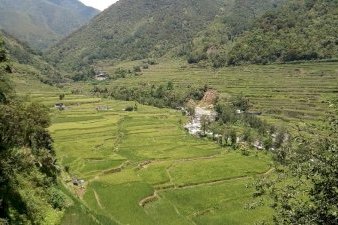
WHS#71
In the Philippines, you grow up hearing about them; seeing pictures of them; memorizing them for your Social Studies or Araling Panlipunan quiz; even having them in your wallet (on the opposite side from President Quezon's face). The Ifugao Rice Terraces! And if there's one thing that unites Pinoys, it's rice. The crop is grown all around the country in the iconic Asian rice paddies. And what happens when you live in the mountains where there's no flat land to make paddies? Well, most would just move to better grounds, but for the people of the Philippine Cordilleras, they created terraces. Now, as an avid traveler, agricultural terraces weren't exactly new to me, and, I'm guessing, for many of you reading this as well. I had previously seen the maize and potato terraces of the Andes, vineyards of Europe, and olive terraces of the Levant. What makes these terraces so special? The sheer beauty of it! In other parts of the world, terraces are basically auxiliary attractions. The Incas just happened to build terraces to support their impressive cities, the Europeans their vineyards nearby their various manors, the Balinese their rice terraces as part of irrigation systems that also provide their temples, and so on. Many of those are either deserted and unkept, rather recent, or not scenic. It's different here in Ifugao, where the terraces, their beauty, their culture, their people, and the experiences they offer are what make a trip to them. I could've spent a …
Keep reading 0 commentsRiccardo Quaranta
Rice Terraces of the Philippine Cordilleras
Rice Terraces of the Philippine Cordilleras (Inscribed)
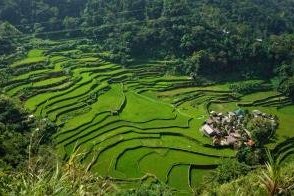
Ifugao, which means People of the Hill, is a province in the Cordillera Administrative Region on the island of Luzon, in the Philippines. This area is famous for the 2000 years old rice terraces that are inscribed in the UNESCO World Heritage List with the name of “Rice Terraces of the Philippine Cordilleras“. This was the first property to be included in the Cultural Landscape category.
The site comprises five clusters of rice terraces: Batad Rice Terraces, Bangaan Rice Terraces, Hungduan Rice Terraces, Mayoyao Rice Terraces and Nagacadan Rice Terraces. I managed to visit the first three of the list and I was stunned by the harmony between the environment and the people living there, who morphed the landscape according to their needs but managed to preserve the environment.
A good way to visit the rice terraces is to stay in Banaue, a small town in the middle of the Cordillera mountain range. Banaue can be reached directly from Manila or nearby bigger cities such as Bontoc, Sagada and Baguio. I took a Jeepney from Sagada which was full so I had to sit on the roof. Although very uncomfortable it was an amazing experience.
From Banaue it is relatively easy to arrange visits to the rice terraces. The easiest way is to hire, either privately or through the local tourist centre, a car or a trike (little motorcycles with side cars) to get as close as possible to the sites.
The Hungduan terraces are completely made of mud walls …
Keep reading 0 commentsGary Arndt
Rice Terraces of the Philippine Cordilleras
Rice Terraces of the Philippine Cordilleras (Inscribed)
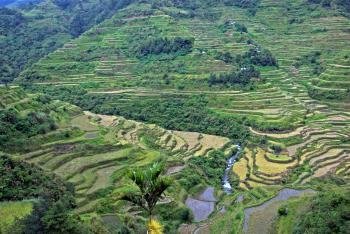
I visited the Rice Terraces in October 2007.
The Rice Terraces of Banaue are easily the most impressive attraction in the Phillippines. The terraces were built over the course of centuries, and the locals like to describe it as the "largest thing built by free humans", which is a dig at the pyramids.
Getting to Banaue takes a bit of time, as you have to go up winding mountain roads, but it isn't too challenging. When I visited in 2007 the only real hotel option was a tourist hotel built during the Macros regime.
If you have to ask the question "what should I go see in the Philippines?", I'd put the Rice Terraces on the top of your list.
Read more about the Rice Terraces of the Philippine Cordilleras on my website.
Keep reading 0 commentsBernard Joseph Esposo Guerrero
Rice Terraces of the Philippine Cordilleras
Rice Terraces of the Philippine Cordilleras (Inscribed)
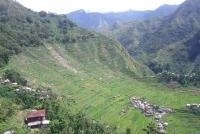
I just recently came from a trip in Ifugao. I was lucky enough to have been guided by a British friend of mine who owns an inn in Uhaj (overseeing the Hungduan Rice Terraces - WHS, which is largely regarded as the first and oldest of the rice terraces clusters in the area). I was able to visit the rice terraces in Banaue, namely Batad and Bangaan in a day -- these two clusters share the same route so maximizing the opportunity to see 2 WHS clusters in one go is a give away. Batad Rice Terraces gave me the impression of might and boldness. Among the 5 clusters inscribed as WHSites, Batad probably holds the steepest terraces (from a distance, it practically looks like a cliff). It's ampitheatre-like landscape is stunning. Going there requires some time and strength as the traveling would consume about 2.5hours, including trekking to the site. On the way back to Banaue town proper, we made a quick visit to Bangaan. Bangaan, on the other hand, is humble and unpretentious. A part of me, in fact, is convinced that Bangaan has a better character than Batad and Hungduan given the landscape and the topography it is located in. Bangaan is a colorful site as with its varying shades of green and brown fields; its small village is also intact in the middle. By and large, the rice terraces of the Philippine Cordilleras are truly amazing and are among the best cultural landscapes there are to …
Keep reading 0 commentsBoj
Rice Terraces of the Philippine Cordilleras
Rice Terraces of the Philippine Cordilleras (Inscribed)
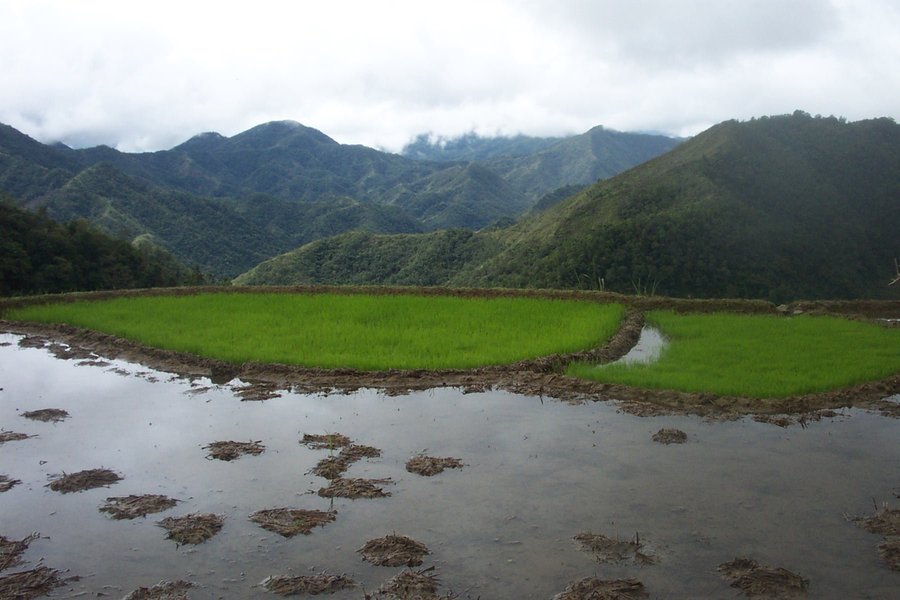
Visited Batad and Bangaan rice terraces last February 2010.
Such an amazing experience! Stayed in Batad Homestay c/o Mang Ramon who can offer the "rice terrace" experience - like preparing rice, bonfire activity, rice wine ceremony at night, staying in one of the native huts.
Apart from the external factors affecting the site, i.e., climate change, El Nino phenomenon, it appears that the problem is internal. The younger Ifugao may have misinterpreted the concept of modernization. Based on the conversations I made with the locals, I learned that a lot of the young people feel that working in big cities and earning money is a sort of "escape" so they won't need to learn all the rituals and techniques in rice planting.
The rice terraces are still beautiful despite all the problems threatening their survival.
Keep reading 0 commentsAnonymous
Rice Terraces of the Philippine Cordilleras
Rice Terraces of the Philippine Cordilleras (Inscribed)

It was a great place! We went there and it was so big - no wonder it is a heritage site! WE visited the farmers, then took a look around. You should fly a plane there - the views are AMAZING!
Also, the degration is quite serious. I think it should be partly closed off to visitors.
Keep reading 0 commentsAnonymous
Rice Terraces of the Philippine Cordilleras
Rice Terraces of the Philippine Cordilleras (Inscribed)

Hello I was at the Banaue Rice Terrace in 2002 March with my wife who is a Philippino. We were so happy we took to time to see this place. I read a few of the other comments and they are right in saying this is amazing to see such engineering. On the return walk back to the peak we stoped at the hut for lunch and watched the terraces for a good hour before leaving. I used to watch these terraces on TV documenarys so it was a very speacal time for me also for my wife to be there to see them and walk on them. The locals are so hard working and happy looking. As we walked back up the mountain feeling sorry for ourselves as our legs weakend we saw many of the locals carrying sacks of rice on their backs keeping pace with us! Tough as billgoats knees they are!
The only thing I found frightning was the drive from Baguio to Banaue at night. We started in the evening and the mountain road made me so scared. When night came I just hung onto the hand rail and just waited to tumble over the side into a valley. The ride was something like 12 hours. But I was astonished when I turned on the GPS to find we where only aprox 75kilometres from Baguio! Your basicly turning and swerving around the mountain top roads. I hope anyone who ventures there has a great time …
Keep reading 0 commentsAnonymous
Rice Terraces of the Philippine Cordilleras
Rice Terraces of the Philippine Cordilleras (Inscribed)

I've just been to this WH site last weekend and the journey itself was an adventure. From downtown Banaue, we rented a tricycle. It was already noontime and the local we've asked about the trip was quite suprised that we'll be going there late that day. I was thinking it would just take us max of 2hours and we'll be in Batad. After about an hour of driving through very rough terrain, the tricycle driver finally stopped and asked that we walk our way to Batad. At that point, I didn't see any rice terraces anywhere so I asked how far the place was. I saw the grin in his face when he said we just need to walk and we'll see the community in no time. This was the longest trail I've ever walked in my entire life. An hour of rough and stony road, and yet no signs of rice terraces. So much for watching too much TV, I thought it was that simple. Finally, we saw a small hut just a few meters away. I can't believe we made it. There was a jeepney parked, few men offering to be trek guide and a small store with drinks to offer. Imagining how far we've gone and how many mountains we've crossed, I was suprised that they have several beverages, the same stuff sold in city supermarket. We stopped for a few minutes, to rest our feet and replenish with lots of water and energy drink. Finally, we …
Keep reading 0 commentsAnonymous
Rice Terraces of the Philippine Cordilleras
Rice Terraces of the Philippine Cordilleras (Inscribed)

Rice Terraces in Banaue town is quite a disappointment compared to the ones in Batad Village, it's really beautiful there, but getting there takes effort. you have to hike from the junction where the road ends to the saddle for about 40 minutes to an hour and from the saddle to Batad Village is an hour down the mountains. the view and the village is really really awe inspiring and just glorious. no words. there's a beautiful waterfalls in Batad, another one hour hike from batad village. batad rice terraces is the best rice terraces i think in whole ifugao province.
Keep reading 0 commentsEls Slots
Rice Terraces of the Philippine Cordilleras
Rice Terraces of the Philippine Cordilleras (Inscribed)

My two days in the Rice Terrace Region of the Cordilleras got off to a bad start: rain was pouring down all of the first day. I didn’t get any further than the Banaue viewpoint and returned to my guesthouse, soaking and with only one gloomy photo of a rice terrace that isn’t even on the list.
It kept on raining during the following night, but things didn’t look too bad the following morning. I decided to make an early start and head for Bangaan. By various means of transport, which even included climbing over a landslide that had occurred during the night, I eventually arrived at the town of Bangaan. It’s picturesque, there is no other word for it. Imagine a valley surrounded by high green mountains, with only steep rice terraces on their lower slopes, and a tiny hamlet in the middle. Or look at the photos around this post.
There’s an enormous variation in shades of green (and some brown), wherever you look. Narrow walls/paths make it possible to walk amidst these rice fields. Because it’s not the rice harvesting season, only fields with seedlings are bright green in December when I visited. But there’s a lot more to these rice terraces than growing rice: their construction technique (a massive effort 2000 years ago) and also the traditions of the Ifugao people that still live here and earn a meager income from the rice (and make a bit on the side by selling souvenirs).
There are several …
Keep reading 0 commentsSolivagant
Rice Terraces of the Philippine Cordilleras
Rice Terraces of the Philippine Cordilleras (Inscribed)
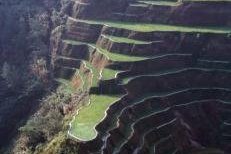
I agree with Ivan ManDy’s evaluation of the Philippine Cordilleras. As I write this review I am looking above my monitor at a wonderful piece of handwoven Ifugao cloth hanging on the wall with its bright reds, blacks, whites and yellows. It is one of my better WHS souvenirs and brings back visions of green rice terraces and peasant girls wearing wearing wrap round skirts of the same cloth. If you do go then by all means visit the “classic” viewing point above Banaue on the road to Bontoc (photo). This however is rather touristy and is packed with old Ifugao ladies puffing enormous pipes waiting to be photographed! So try also to visit some of the lesser known valleys away from the tourist trap of Banaue. We had a rent-a-car which made this easier though it is better still to take to the footpaths. Driving in the Philippines among the “Jeepnies” which give no quarter in the battle for road space is an experience in itself. Indeed the Philippines has a lot going for it as a tourist destination – and the Rice terraces are certainly “worth the journey”.
However Ivan ManDy is only partially right in his assertion that the Philippine Cordillera was the first “Cultural Landscape” site to be inscribed. It was indeed the first to be so inscribed from scratch and the first purely on cultural criteria but Tongariro in New Zealand was re-designated a “Cultural Landscape” in 1993 as was Uluru in Australia in 1994. …
Keep reading 0 commentsIvan ManDy
Rice Terraces of the Philippine Cordilleras
Rice Terraces of the Philippine Cordilleras (Inscribed)
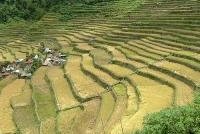
The Rice Terraces is (if Im not mistaken) the first world heritage site of UNESCO under the 'cultural landscape' title.
It was only when I visited it for the second time (and explored further) did I realize the great extent of these terraces! The expanse is truly amazing - one town to another can take as much as 4 hours to reach by car! And to think that these terraces were carved in the mountains by hand! Only when you visit the Rice Terraces can you realize the primal importance of this crop to Filipino (and Asian) culture.
Keep reading 0 commentsAnonymous
Rice Terraces of the Philippine Cordilleras
Rice Terraces of the Philippine Cordilleras (Inscribed)

There is a plan to construct a road to Batad where the most beautiful part of the terrraces are found.
The plan should be discouraged. Else, the awesome natural beauty would be permanently lost to the invasion of distractive technology like those which sprouted in Banaue central.
Keep reading 0 commentsAnonymous
Rice Terraces of the Philippine Cordilleras
Rice Terraces of the Philippine Cordilleras (Inscribed)

I have been doing documentaries on most places and cultures in the Philippine Cordilleran Region and have gone about the rice terraces of the Mountain Provinces and of Ifugao. Looking at the stark wonder of it all would make one sad with the realization that this culture is slowly going to dust. With hard life ahead and modernization eating up every corner of the world, we should make efforts to preserve what is left of the past. That the future generations may have something to appreciate. Lack of funding to do all these is a very big problem, but I guess a little wonder at a time could make a difference. Educating the youth, community rehabilitation campaigns and programs, culture and tradition immersions, environmental missions, these all can do a lot.
Keep reading 0 commentsAnonymous
Rice Terraces of the Philippine Cordilleras
Rice Terraces of the Philippine Cordilleras (Inscribed)

The Rice Terraces are really a stunning piece of landscape architecture. Only when you walk on the terraces itself can you realise the great expanse of the place. My hats off to the Ifguao people who built this cultural landscape! With the amount of 'modernization' going through the place, I just hope I'll still be able to visit it afterlife (in the next 1000 years)!
Keep reading 0 commentsAnonymous
Rice Terraces of the Philippine Cordilleras
Rice Terraces of the Philippine Cordilleras (Inscribed)

The rice terraces are already showing signs of irreversible degradation especially those in that are accessible to land transportation. Structures are indiscriminately built on the terraces areas. Some areas are abandoned as people leave the place in search for more economically viable livelihood activities. The rice terraces is taken cared of by the older people with the younger generation getting aversed to terrace work as they get more educated. When nobody is willing to work in the rice terraces, that means the end of this heritage. Yet the national government is not concerned as shown by its abolition of the Banaue Rice Terraces Task Force and passed on the responsibility to the Provincial Government. The Provincial Government is so cash strapped that it depends on funding allocation from the national government with no other fund sources.
Keep reading 0 comments
